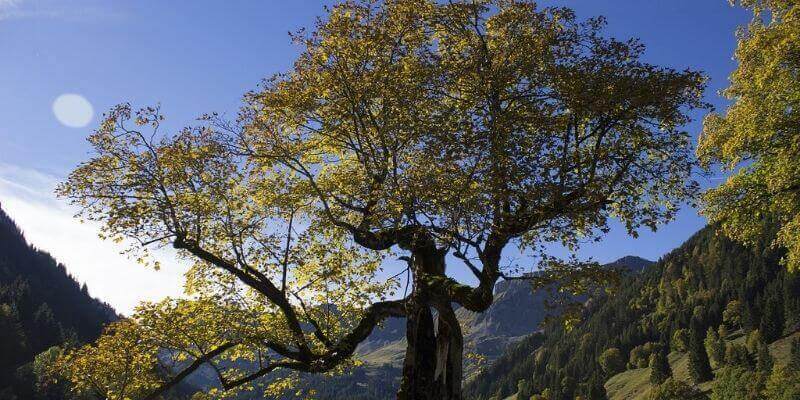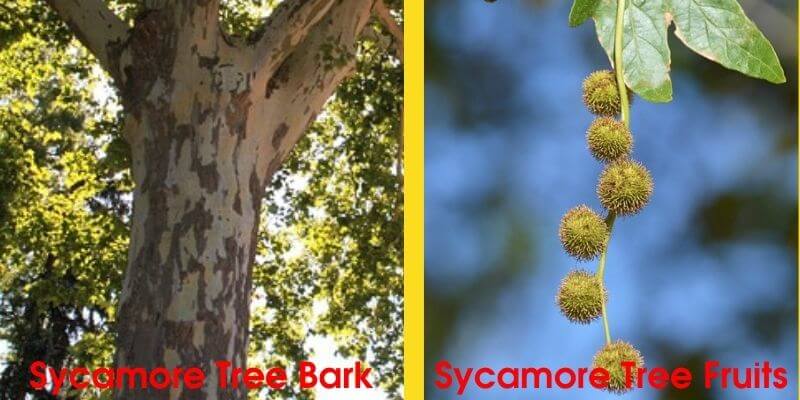Sycamore Tree Facts
Today we will learn about the Sycamore Tree, which is full of amazing and fascinating facts.

Did you know? Paleobotanists have considered this tree family to exist on the earth for more than 100 million years, and some Sycamore trees can live up to 500–600 years.
The Sycamore tree (Platanus occidentalis), a deciduous tree, belongs to the plane-tree family. These trees are native to southeastern Europe, Asia Minor, and North America, but it can be found around the world today.
Basically, there are THREE types of sycamores depending on their size, color of bark and leaves, and habitat: North American sycamore, British sycamore, and Middle Eastern sycamore.
Amazing Facts About Sycamore Tree
FACT 1. ➤ It is believed that the word “Sycamore” comes from the Greek word ‘sukomoras‘ means ‘fig-mulberry,’ a native Mediterranean fig tree, and was borrowed in English via Old French languages.
FACT 2. ➤ American sycamore tree is also known as “ghost trees” because of their white branches in the upper part of the crown, resulting from leaves falling from them.
FACT 3. ➤ Sycamore tree bark – The bark of the sycamore is covered with a whitish and reddish-brown patched surface. Creamy patches represent newly formed bark, while reddish-brown patches represent old bark.
FACT 4. ➤ Sycamore tree leaf – It has broad leaves with 3-5 lobes with pointed tips. Sycamore leaves look like maple leaves.

FACT 5. ➤ Sycamore trees measure up to 98 to 130 feet in height and 4.9 to 6.6 feet in diameter.
FACT 6. ➤ Sycamore is a monoecious plant, which means that it consists of individual male and female flowers on the separate twigs on the same plant.
FACT 7. ➤ Sycamore has the largest leaf of any tree in North America.
FACT 8. ➤ Seeds of sycamore are arranged in V-shaped pairs. One tree produces up to 10,000 seeds per season.
FACT 9. ➤ Seeds of sycamore are known as “helicopters” because of their wings that rotate similar to helicopter’s propellers on the wind.
FACT 10. ➤ The fruits of sycamore look like a brownish woody ball that ripens in October.
FACT 11. ➤ Sycamore has the largest leaf of any tree in North America.
FACT 12. ➤ The Lafayette Sycamore tree in Brandywine Battlefield Park, Pennsylvania, is believed to be 300 years old. This tree protected the soldiers of General Washington during the Battle of Brandywine in 18th century. Since then, the sycamore tree has become a symbol of hope and protection in the USA.
FACT 13. ➤ In the Kikuyu Tribe of Kenya, the Sycamore and the Fig Tree were considered sacred.
FACT 14. ➤ During ancient times, these trees were considered extremely important in Israel. This tree was considered one of the sources of food that were destroyed by the plagues in Egypt (source).
FACT 15. ➤ During ancient times, the Sycamore Tree symbolized “regeneration.” because of its amazing ability to regenerate.
What is a Sycamore Tree in the Bible?
The word “sycamore” appears seven times in the OT—for instance in 1 Kings 10:27, “He made cedars as plentiful as the sycamore,” and Amos 7:14 “a herdsman, and a dresser of sycamore.” The most important mention is, however, in Luke 19:4 when Zacchaeus climbed up into a sycamore tree in order to see the Lord Jesus.
Sycamore comes from sykē (fig) and mora (a mulberry). In the NT the tree is mentioned under its Gr. name συκομορέα, G5191. There is no doubt that the tree is the sycamore fig, Ficus sycomorus, often called the fig-mulberry. The tree known today as the sycamore is the Acer pseudo platanus. [content source:https://www.biblegateway.com/resources/encyclopedia-of-the-bible/Sycamore]
Sycamore Tree Care
Once a sycamore tree is established, generally within 5 to 6 years after planting, it is unlikely to need much attention. However, the more it is pampered when young, the more likely it is to reach adulthood in good health.
- Give sycamores a deep soaking once per week in the first few years after planting and on a monthly basis thereafter.
- Spreading 1 to 2 inches of compost over the roots zone of young trees each fall helps to build the rich topsoil that sycamores love.
- Maintaining a deep layer of mulch over the root zone of the tree helps to conserve moisture and keep the roots cool.
- As the tree grows, prune off any branches on the lower half of the tree until the lowest branches are a minimum of 10 feet from the ground, at which point they can be left as the permanent scaffold branches for the life of the tree.
Sycamore Tree care content is taken from – https://garden.lovetoknow.com/trees/sycamore-trees
You can also read the article of Hollie Carter to know about sycamore tree care, sycamore tree pruning, sycamore tree allergy and diseases etc.
Test your knowledge – Plant Quiz
